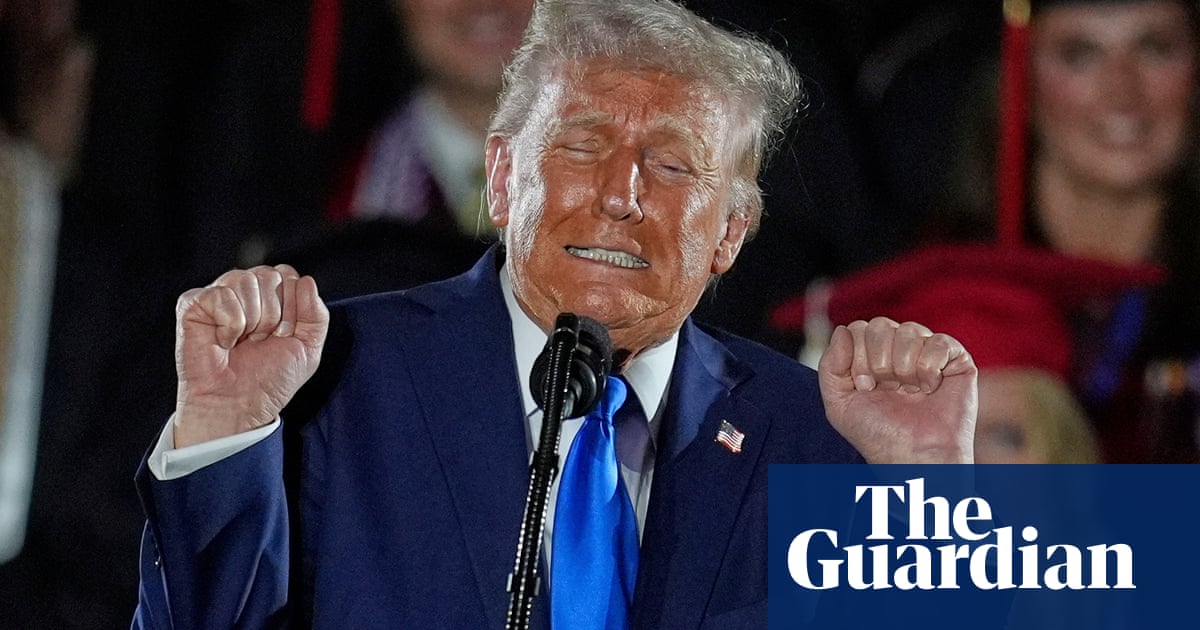A Hundred Days of Trump: A Rollercoaster of Praise and Pushback
“Not just courageous” but “actually fearless,” proclaimed Doug Burgum, highlighting a sentiment echoed by many supporters as Donald Trump embarked on his presidency. Pam Bondi described his first 100 days as “far exceeded that of any other presidency in this country ever.” However, political commentator JD Vance took a more critical stance, articulating that many past presidents, including titans like George Washington and Abraham Lincoln, were merely “placeholders” devoid of “action.”
The Spectacle of Praise
The atmosphere at the White House during these early days was thick with accolades. High-ranking cabinet officials, under the glaring lights of television cameras, lavished praise on Trump akin to what one might expect in more autocratic regimes, leading some critics to draw uncomfortable parallels with North Korea. Yet, outside the gilded walls of the Oval Office, a different narrative was brewing.
Shifting Economic Landscape
Data emerging during this period began to paint a troubling picture: the economy was contracting. As the national security adviser faced impending ousting, public opinion polls reflected an eerie truth; Trump’s popularity was sinking to unprecedented lows. The jubilant atmosphere that characterized the beginning of his term was giving way to feelings of doubt and anxiety.
Political Reality Sets In
“The honeymoon is over,” remarked John Zogby, a seasoned pollster. His insights suggested that Trump may have squandered his early political capital by taking on too much too quickly, without securing substantial victories. “At the end of the 100 days, his polling numbers reflect an unsuccessful quarter,” he observed, noting that many polls showed Trump’s approval in a steep decline.
A Bold Start
When Trump took office on January 20, he seemed politically invincible. Having narrowly defeated Kamala Harris in critical swing states, he entered the presidency exuding a sense of vindication. Energized by the backing of tech elites and media figures visiting his Mar-a-Lago estate, Trump launched an ambitious agenda from the get-go.
Executive Orders and Legislative Bypass
In these initial days, Trump was relentless, signing over 140 executive orders—a record number. This aggressive approach left Democrats reeling, akin to a boxer hit with a surprise flurry of punches. Trump effectively marginalized Congress and positioned himself as a central force against established institutions, targeting judges and emboldening figures like Elon Musk, who were eager to dismantle the federal bureaucracy.
Overreach and Backlash
However, the momentum began to shift when Trump declared April 2 as “liberation day,” unveiling sweeping global tariffs. This bold trade maneuver backfired, unsettling allies and erasing trillions in market value. Fearing economic chaos, Trump opted to pause but maintained high tariffs on Chinese goods, a move met with resistance from Beijing.
A Deteriorating Confidence
The fallout from Trump’s chaotic policies rattled the faith of his supporters, many of whom had hoped for an era of economic stability. Escalating food prices and supply chain disruptions led to stark reminders of pandemic-era shortages. In a moment of vulnerability, Trump candidly suggested that children might have "two dolls instead of 30 dolls" this Christmas, attempting to shift blame to his predecessor, Joe Biden.
Immigration Policies Under Scrutiny
Even on immigration—one of Trump’s signature issues—he faced mounting criticism. As he sent troops to the border and expanded deportation targets, a lower rate of illegal crossings was achieved. Yet legal challenges emerged against his aggressive enforcement tactics, culminating in the scandalous deportation of Kilmar Ábrego García, a Maryland resident with protected status.
Promises Unfulfilled
Despite his vows to swiftly resolve conflicts in Ukraine and Gaza, those wars raged on, leaving Trump’s promises in the lurch. The resignation of national security adviser Mike Waltz marked another point of instability, as he transitioned to a new role as the U.S. ambassador to the UN.
Approval Ratings in Decline
Trump’s ambitions to exert authoritarian control clashed with the reality of his administration’s inefficacy. He found himself in unfamiliar territory, boasting the lowest approval ratings at the 100-day mark of any president in the last 80 years. A poll by the Washington Post and ABC News showed only 39% approval, with 64% believing he was overreaching in his attempts to consolidate power.
Expanding Opposition
Protests against Trump proliferated, serving as tangible manifestations of a growing resistance. Lawsuits blocked approximately 50 of his executive orders, while likewise invigorating democratic engagement in traditionally red territories. Democrats found a renewed voice, ready to challenge the chorus of praise that once drowned out dissent.
The Momentum Shift
Commentators noted a crucial turning point; Trump, once seen as an unstoppable force, now faced an invigorated opposition. Charlie Sykes observed that the initial aura of invincibility began to wane, as courts and markets reacted against his policies, suggesting that the once-fearless Trump administration was now confronting widespread resistance.
Historical Context and Future Implications
The stark realities faced by Trump were not unique in the annals of presidential history. Notably, Joe Biden, who began with a robust approval rating, saw his own numbers dip following controversies like the chaotic withdrawal from Afghanistan. Political analysts often warn that parties in power tend to suffer during midterm elections.
As the landscape continued to evolve, Republicans found themselves in a precarious position. With approximately a two-seat majority in the House, worries about shifting voter sentiments intensified. Observers noted the potential for opposition to grow stronger and more vociferous as 2026 approached, compelling some Republicans to distance themselves from Trump’s agenda.
Through these initial hundred days, a whirlwind of ambitious policy launches, rapid deterioration in public opinion, and swelling opposition defined Trump’s early presidency, marking a tumultuous chapter in American political history.


